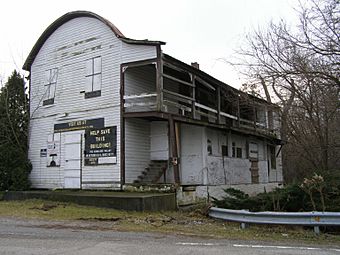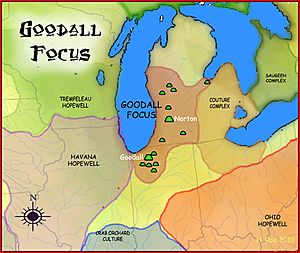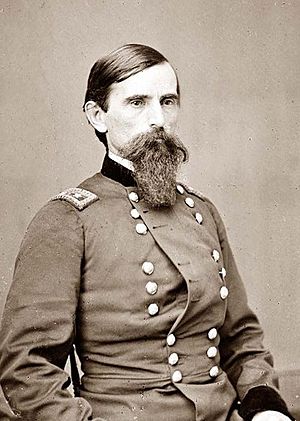Collier Lodge Site facts for kids
The Collier Lodge Site is a very special place in Porter County, Indiana. It's one of the few spots where people could easily cross the huge Kankakee Marsh. People have lived here for over 11,000 years!
Archaeologists have found amazing clues about human life from as far back as 1,000 B.C.E. They've also found records from the late 17th century about people living in Northwest Indiana. The old tools, pottery, and other items found here are unique for this part of Indiana.
Scientists have discovered different types of ancient cooking pits and other small features. They also found parts of a fireplace, old post molds, and what might be a hidden cellar from a building no one knew about. Lots of animal bones from the early 1800s show that people used to process animal furs here.
The Collier Lodge Site has many artifacts and features. It's the only place in northwestern Indiana where archaeologists have found a complete set of pottery from different time periods. These old items, like stone tools, pottery, and metal pieces, help us learn about ancient technology, trade, and how people lived. The site also has well-preserved animal and plant remains. These help us understand what people ate, how they got food, and what the environment was like long ago.
Contents
What Was the Kankakee Like?
The Kankakee River valley has sandy ridges and old river channels. The river was straightened between 1906 and 1917. The Collier Lodge Site sits on one of these dry ridges, right next to an old river channel.
Before 1917, the marsh was a rich home for many plants and animals. This dry ridge, surrounded by the marsh, was a perfect spot for both humans and animals. The area was shaped by melting glaciers long ago. This created a wide, flat valley that became the marsh. Over thousands of years, wind moved sand to create sandy plains and sand dunes. These sandy areas drained water well, making them good places for people to live.
This high, dry area was right next to the Kankakee Marsh. It was also one of the easiest places to cross the marsh. Different sand ridges met here, making it a natural pathway. This crossing was known as Pottawatommie Ford. It was called "the most historic spot along the Kankakee in the marsh proper." The site is about 1 acre (0.40 ha) and is next to the Collier Lodge building. It's on a sand ridge on the north side of the old river channel. This area was very rich in nature until the river was changed.
Who Lived Here?
People lived at this site for a very long time! From the Early Archaic period (around 9000 B.C.) all the way up to recent times.
Archaeologists have found signs of people from different periods:
- The Early Woodland (1000 – 200 B.C.)
- Parts of the Upper Mississippian period (A.D. 1400 - 1500)
- The Historic period, which started in 1840 A.D. This includes the Pioneer period (1840 – 1880) and the Hunting Lodge period (late 1800s).
A Look Back in Time
We can learn about four main historic periods at the Collier Lodge site.
Native American Period (Before 1840)
This site shows us the long history of Indiana, from the Early Archaic (around 9000 B.C.E.) to modern times. The oldest items found are stone tools from the Early Archaic period.
Archaeologists have found many types of stone tools, including projectile points and other sharp tools. They also found chips of stone from when tools were made or fixed. Other interesting items include grinding stones, a gorget (a type of necklace), a birdstone (a carved stone bird), and pieces of pipes.
Pottery from different periods has also been found:
- Upper Mississippian (after 1050 A.D.)
- Early Woodland (around 800 – 150 B.C.), when pottery first appeared in the region.
- Middle Woodland (around 150 B.C. – A.D. 350)
- Late Woodland (around A.D. 350 – 1050)
Later, historic pottery from the early 1800s to recent times was found. This includes fine earthenware and coarser crockery.
Early hunter-gatherers used the site for short visits during certain seasons. This continued into the Early Woodland period. Later, people from the Middle Woodland Goodall focus tradition (around 250 B.C. to A.D. 350) lived here. They were part of the regional Hopewell tradition. They might have started growing corn near the site around this time.
During the Upper Mississippian period (after A.D. 1050), people from the Oneota culture used the marsh resources a lot. Later, a culture that isn't fully identified yet likely became the Native American tribes we know from the 1600s and 1700s. The Potawatomi are the first historically known group to live here.
Pioneer Period (1840-1880)
During this time, pioneers settled the area. We know this from the remains of a cabin, household trash, and animal bones. The evidence suggests people were involved in fur trading or trapping.
J. Sherwood and his family were the first settlers to stay at the site. In 1836, George Eaton came to what was called Potawatomi Ford. He built a cabin and started Eaton's Ferry. In 1848, a bridge was built, but it burned down. Eaton went back to running the ferry until he died in 1851. His wife continued the ferry until her death in 1857.
After that, Sawyer took over the ferry. Then, Enos Baum built a toll bridge across the Kankakee at the same spot. Since then, the area has been known as Baum's Bridge. The Collier family later built Collier Lodge. At this time, the area had brushy plants and oak trees. Around the dry sandy islands, there were thick swamp trees, with the marsh to the south. This was probably similar during earlier times too. The Kankakee River was the western border. The narrow channel near Collier Lodge today is what's left of the river before it was straightened.
Ranchers and Recreation Period (1880-1910)
In the late 1800s and early 1900s, hunting lodges near Baum's Bridge became popular. Hunting and fishing became a fun activity for wealthy city people in the 1870s. Local farmers and businesses became guides and offered places to stay.
Famous people like President Benjamin Harrison and General Lew Wallace came here to hunt and fish. By the 1890s, it became more common for women to enjoy outdoor activities like fishing too.
Near the bridge, a group of wealthy hunters from Pittsburgh built a clubhouse in 1876. They called it the Pittsburgh Gun Club. Other clubs were built along the river, including one by hunters from Louisville, Kentucky. In 1873, the Columbia Hunting Club, made up of business people from Hebron, Indiana, built on Deserter's Island. Heath & Milligan from Chicago bought land on School Grove Island and built Camp Milligan in 1869. Other clubs at Baum's Bridge included those from Indianapolis, Terre Haute, and Rockville.
The way people enjoyed sports at Baum's Bridge changed over time. In the 1870s, only men hunted and fished. But by 1920, both men and women enjoyed spending time by the river.
Many historic items from this period have been found. These include:
- Glass bottles and containers
- Tableware
- Window glass
- Buttons
- Metal items made of aluminum, brass, copper, iron, lead, silver, and tin.
- Iron and brass hardware from the fur trade.
Animal bones from both wild and farm animals show what creatures lived in the region. These include mammals, fish, birds, reptiles, and farm animals like cows, horses, pigs, chickens, and dogs.
Reclamationists and Resorters Period (1910-1936)
One of the old trails became a road connecting Michigan City and Logansport. Today, Baum's Bridge Road still follows that path. By the mid-1800s, a sawmill was operating on the river. It used the river to transport cut logs.
The Collier Lodge building was built in the late 1800s. An older cabin was taken down to make way for the new building. The site continued to be used by people who enjoyed sports. After 1900, Collier Lodge became a small country inn and a general store. By the mid-1900s, it was a private home.
Gallery
Images for kids












